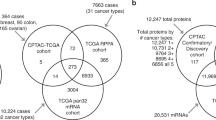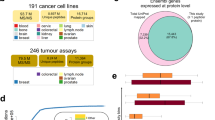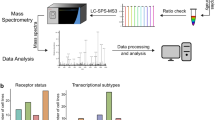Abstract
Achieving information content of satisfactory breadth and depth remains a formidable challenge for proteomics. This problem is particularly relevant to the study of primary human specimens, such as tumor biopsies, which are heterogeneous and of finite quantity. Here we present a functional proteomics strategy that unites the activity-based protein profiling and multidimensional protein identification technologies (ABPP-MudPIT) for the streamlined analysis of human samples. This convergent platform involves a rapid initial phase, in which enzyme activity signatures are generated for functional classification of samples, followed by in-depth analysis of representative members from each class. Using this two-tiered approach, we identified more than 50 enzyme activities in human breast tumors, nearly a third of which represent previously uncharacterized proteins. Comparison with cDNA microarrays revealed enzymes whose activity, but not mRNA expression, depicted tumor class, underscoring the power of ABPP-MudPIT for the discovery of new markers of human disease that may evade detection by other molecular profiling methods.
This is a preview of subscription content, access via your institution
Access options
Subscribe to this journal
Receive 12 print issues and online access
$259.00 per year
only $21.58 per issue
Buy this article
- Purchase on Springer Link
- Instant access to full article PDF
Prices may be subject to local taxes which are calculated during checkout




Similar content being viewed by others
References
Kramer, R. & Cohen, D. Functional genomics to new drug targets. Nat. Rev. Drug Discov. 3, 965–972 (2004).
Patterson, S.D. & Aebersold, R. Proteomics: the first decade and beyond. Nat. Genet. 33, 311–323 (2003).
Patton, W.F., Schulenberg, B. & Steinberg, T.H. Two-dimensional electrophoresis: better than a poke in the ICAT? Curr. Opin. Biotechnol. 13, 321–328 (2002).
Gygi, S.P. et al. Quantitative analysis of complex protein mixtures using isotope-coded affinity tags. Nat. Biotechnol. 17, 994–999 (1999).
Washburn, M.P., Wolters, D. & Yates, J.R., III . Large-scale analysis of the yeast proteome by multidimensional protein identification technology. Nat. Biotechnol. 19, 242–247 (2001).
Chaurand, P., Sanders, M.E., Jensen, R.A. & Caprioli, R.M. Proteomics in diagnostic pathology: profiling and imaging proteins directly in tissue sections. Am. J. Pathol. 165, 1057–1068 (2004).
Petricoin, E.F. & Liotta, L.A. SELDI-TOF-based serum proteomic pattern diagnostics for early detection of cancer. Curr. Opin. Biotechnol. 15, 24–30 (2004).
Durr, E. et al. Direct proteomic mapping of the lung microvascular endothelial cell surface in vivo and in cell culture. Nat. Biotechnol. 22, 985–992 (2004).
Gygi, S.P., Rist, B., Griffin, T.J., Eng, J. & Aebersold, R. Proteome analysis of low-abundance proteins using multidimensional chromatography and isotope-coded affinity tags. J. Proteome Res. 1, 47–54 (2002).
Kobe, B. & Kemp, B.E. Active site-directed protein regulation. Nature 402, 373–376 (1999).
Zangar, R.C., Varnum, S.M., Covington, C.Y. & Smith, R.D. A rational approach for discovering and validating cancer markers in very small samples using mass spectrometry and ELISA microarrays. Dis. Markers 20, 135–148 (2004).
Jessani, N. & Cravatt, B.F. The development and application of methods for activity-based protein profiling. Curr. Opin. Chem. Biol. 8, 54–59 (2004).
Speers, A.E. & Cravatt, B.F. Chemical strategies for activity-based proteomics. ChemBioChem. 5, 41–47 (2004).
Jessani, N., Liu, Y., Humphrey, M. & Cravatt, B.F. Enzyme activity profiles of the secreted and membrane proteome that depict cancer invasiveness. Proc. Natl. Acad. Sci. USA 99, 10335–10340 (2002).
Jessani, N. et al. Carcinoma and stromal enzyme activity profiles associated with breast tumor growth in vivo. Proc. Natl. Acad. Sci. USA 101, 13756–13761 (2004).
Pang, J.X., Ginanni, N., Dongre, A.R., Hefta, S.A. & Opitek, G.J. Biomarker discovery in urine by proteomics. J. Proteome Res. 1, 161–169 (2002).
Liu, H., Sadygov, R.G. & Yates, J.R., III . A model for random sampling and estimation of relative protein abundance in shotgun proteomics. Anal. Chem. 76, 4193–4201 (2004).
Liu, Y., Patricelli, M.P. & Cravatt, B.F. Activity-based protein profiling: the serine hydrolases. Proc. Natl. Acad. Sci. USA 96, 14694–14699 (1999).
Andreasen, P.A., Kjoller, L., Christensen, L. & Duffy, M.J. The urokinase-type plasminogen activator system in cancer metastasis: a review. Int. J. Cancer 72, 1–22 (1997).
Huang, Y., Wang, S. & Kelly, T. Seprase promotes rapid tumor growth and increased microvessel density in a mouse model of human breast cancer. Cancer Res. 64, 2712–2716 (2004).
Gallardo-Williams, M.T., Maronpot, R.R., Wine, R.N., Brunssen, S.H. & Chapin, R.E. Inhibition of the enzymatic activity of prostate-specific antigen by boric acid and 3-nitrophenyl boronic acid. Prostate 54, 44–49 (2003).
Okerberg, E.S. et al. High-resolution functional proteomics by active-site peptide profiling. Proc. Natl. Acad. Sci. USA 102, 4996–5001 (2005).
Chen, W.T., Kelly, T. & Ghersi, G. DPPIV, seprase, and related serine peptidases in multiple cellular functions. Curr. Top. Dev. Biol. 54, 207–232 (2003).
Arai, H. Platelet-activating factor acetylhydrolase. Prostaglandins Other Lipid Mediat. 68–69, 83–94 (2002).
Sorlie, T. Gene expression patterns of breast carcinomas distinguish tumor subclasses with clinical implications. Proc. Natl. Acad. Sci. USA 98, 10869–10874 (2001).
Huber, M.A. et al. Fibroblast activation protein: differential expression and serine protease activity in reactive stromal fibroblasts of melanocytic skin tumors. J. Invest. Dermatol. 120, 182–188 (2003).
Scanlan, M.J. et al. Molecular cloning of fibroblast activation protein alpha, a member of the serine protease family selectively expressed in stromal fibroblasts of epithelial cancers. Proc. Natl. Acad. Sci. USA 91, 5657–5661 (1994).
Kelly, T., Kechelava, S., Rozypal, T.L., West, K.W. & Korourian, S. Seprase, a membrane-bound protease, is overexpressed by invasive ductal carcinoma cells of human breast cancers. Mod. Pathol. 11, 855–863 (1998).
Leung, D., Hardouin, C., Boger, D.L. & Cravatt, B.F. Discovering potent and selective reversible inhibitors of enzymes in complex proteomes. Nat. Biotechnol. 21, 687–691 (2003).
Sieber, S.A., Mondala, T.S., Head, S.R. & Cravatt, B.F. Microarray platform for profiling enzyme activities in complex proteomes. J. Am. Chem. Soc. 126, 15640–15641 (2004).
Adam, G.C., Sorensen, E.J. & Cravatt, B.F. Proteomic profiling of mechanistically distinct enzyme classes using a common chemotype. Nat. Biotechnol. 20, 805–809 (2002).
Greenbaum, D. et al. Chemical approaches for functionally probing the proteome. Mol. Cell. Proteomics 1, 60–68 (2002).
Barglow, K.T. & Cravatt, B.F. Discovering disease-associated enzymes by proteome reactivity profiling. Chem. Biol. 11, 1523–1531 (2004).
Saghatelian, A., Jessani, N., Joseph, A., Humphrey, M. & Cravatt, B.F. Activity-based probes for the proteomic profiling of metalloproteases. Proc. Natl. Acad. Sci. USA 101, 10000–10005 (2004).
Chan, E.W., Chattopadhaya, S., Panicker, R.C., Huang, X. & Yao, S.Q. Developing photoactive affinity probes for proteomic profiling: hydroxamate-based probes for metalloproteases. J. Am. Chem. Soc. 126, 14435–14446 (2004).
Liu, Y. et al. Wortmannin, a widely used phosphoinositide 3-kinase inhibitor, also potently inhibits mammalian polo-like kinase. Chem. Biol. 12, 99–107 (2005).
Eisen, M.B., Spellman, P.T., Brown, P.O. & Botstein, D. Cluster analysis and display of genome-wide expression patterns. Proc. Natl. Acad. Sci. USA 95, 14863–14868 (1998).
Kidd, D., Liu, Y. & Cravatt, B.F. Profiling serine hydrolase activities in complex proteomes. Biochemistry 40, 4005–4015 (2001).
Zhao, H. et al. Different gene expression patterns in invasive lobular and ductal carcinomas of the breast. Mol. Biol. Cell 15, 2523–2536 (2004).
Acknowledgements
We thank D. Cociorva for help with DTASelect and Sequest. This work was supported by the US National Institutes of Health grants CA087660 (to B.F.C.) and HG00030 (to M.N.), the California Breast Cancer Research Foundation (B.F.C. and S.S.J.), the Susan G. Komen Breast Cancer Foundation (B.Q.W.) and the Skaggs Institute for Chemical Biology.
Author information
Authors and Affiliations
Corresponding author
Ethics declarations
Competing interests
The authors declare no competing financial interests.
Supplementary information
Supplementary Fig. 1
Structures of fluorophosphonate (FP) ABPP probes. (PDF 358 kb)
Supplementary Fig. 2
Enzyme activity profiles for primary human breast tumor and normal breast specimens determined by 1D-gel ABPP. (PDF 2922 kb)
Supplementary Fig. 3
Representative gel showing molecular mass annotations of enzyme activities used in the clustering analysis shown in Figure 2b of the manuscript. (PDF 2310 kb)
Supplementary Fig. 4
Gene expression profiles for differentially expressed enzyme activities in primary human breast tumor and normal breast specimens. (PDF 313 kb)
Supplementary Table 1
Clinical data on breast tumors. (PDF 67 kb)
Supplementary Table 2
A complete list of the FP-labeled serine hydrolase activities identified in primary human breast tumor and normal breast specimens. (PDF 66 kb)
Supplementary Table 3
Reproducibility of enzyme activity data for ER(-)/PR(-) breast tumor BC48. (PDF 42 kb)
Rights and permissions
About this article
Cite this article
Jessani, N., Niessen, S., Wei, B. et al. A streamlined platform for high-content functional proteomics of primary human specimens. Nat Methods 2, 691–697 (2005). https://doi.org/10.1038/nmeth778
Received:
Accepted:
Published:
Issue Date:
DOI: https://doi.org/10.1038/nmeth778
This article is cited by
-
ATGL is a biosynthetic enzyme for fatty acid esters of hydroxy fatty acids
Nature (2022)
-
Mechanism-based traps enable protease and hydrolase substrate discovery
Nature (2022)
-
Discovery of small-molecule enzyme activators by activity-based protein profiling
Nature Chemical Biology (2020)
-
High-Resolution Confocal Fluorescence Imaging of Serine Hydrolase Activity in Cryosections – Application to Glioma Brain Unveils Activity Hotspots Originating from Tumor-Associated Neutrophils
Biological Procedures Online (2020)
-
Pharmacological convergence reveals a lipid pathway that regulates C. elegans lifespan
Nature Chemical Biology (2019)



